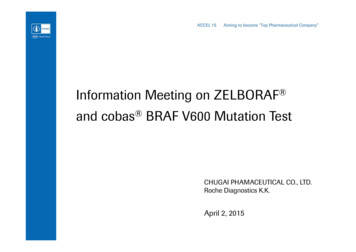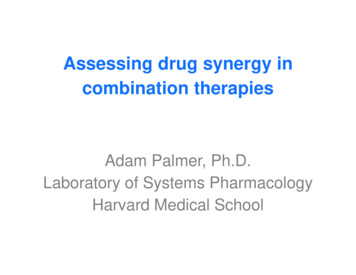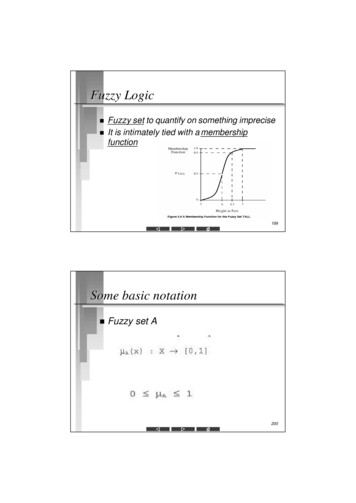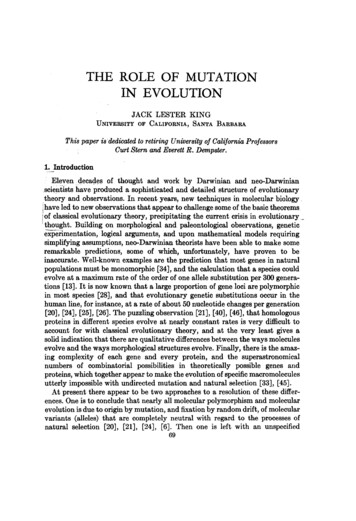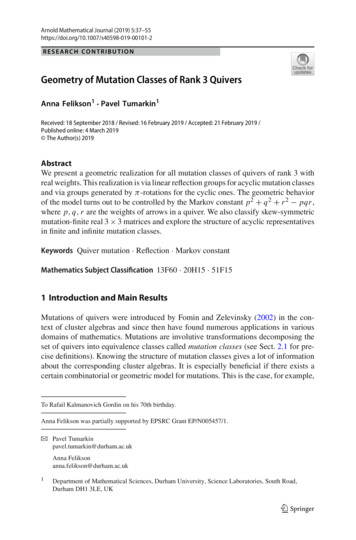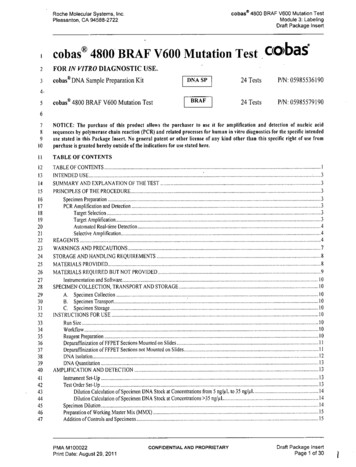
Transcription
cobas 4800 BRAF V600 Mutation TestModule 3: LabelingDraft Package InsertRoche Molecular Systems, Inc.Pleasanton, CA 94588-2722Icobas 4800 BRAF V600 Mutation Test2FOR IN VITRO DIAGNOSTIC USE.3cobas DNA Sample Preparation Kit4,5cobas 4800 BRAF V600 Mutation TestIRgAF1c(obase24 TestsP/N: 0598553619024 TestsP/N: 05985579190678910NOTICE: The purchase of this product allows the purchaser to use it for amplification and detection of nucleic acidsequences by polymerase chain reaction (PCR) and related processes for human invitro diagnostics for the specific intendeduse stated in this Package Insert. No general patent or other license of any kind other than this specific right of use frompurchase isgranted hereby outside of the indications for use stated here.IITABLE OF CONTENTS121314I51617192021. . . . . . .TABLE OF CONTENTS.INTENDED USE3.SUMMARY AND EXPLANATION OF THE TEST.PRINCIPLES OF THE PROCEDURE.3.3e o . . . . . . . . . . . . . . . .Specimen Preparation .PCR Amplification and Detectio .3. . . . . . . . . . .T arget Selection .Target Amplification .4. . . . .Automated Real-time Detection.4Selective Am plification . . . . . . . . . . . . . . 647. . . . . .4. .U MS.REAG ENTTS HL7WARNINGS AND PRECAUTIONS. 8STORAGE AND HANDLING REQUIREMENTS .8.PROVIDED.ROVIDMATERIALS.9MATERIALS REQUIRED BUT NOT PRO VIDED. 1Instrumentation and Sofiware.I.1.SPECIMEN COLLECTION, TRANSPORT AND STORAGE .10. . . . . . . . . . . . . . .A. Specim en Collection . .1B. Specim en Transport . . I . . . . .1. .C. Specim en Storage .10I. . .INSTRUCTIONS FOR USERun Size . .0. 10Workflow . 0.Reagent Preparation . 11Deparaffinization of FFPET Sections Mounted on Slides . 11Deparaffinization of FFPET Sections not Mounted on Slides.12. . . .DNA 1solation . . . 13DNA Quantitation.13AM PLIFICATION AND DETECTION .13.Instrum ent Set-U pI3.Test Order Set-U p ution Calculation of Specimen14.4. 35ng/ILStockatConcentrationsSpecimenDNADilution Calculation of.14.Specimen Dilution. 15Preparation of Working Master Mix (MMX) .I5.Addition of Controls and Specimens .18PMA M100022Print Date: August 29, 2011CONFIDENTIAL AND PROPRIETARYDraft Package InsertPage 1 of 30
cobase 4800 BRAF V600 Mutation TestModule 3: LabelingDraft Package InsertRoche Molecular Systems, Inc.Pleasanton, CA 94588-2722. . . . . . I .6Starting PC R .16.INTERPRETATION OFRESULTS . 17Retesting of Specimens with Invalid Results.I7.Q UALITY CONTROL . 1. 17. .BRAF MutantControl. .17.BRA F Wild-Type Control .17. .PROCEDURAL PRECAUTIONS. . 17PROCEDURAL LI MITA TION .I.8NON-CLINICAL PERFORMANCE EVALUATION. .I7.I.Analytical Sensitivity - Limit of Blank (LoB).18Analytical Sensitivity- Limit of Detection (LoD) .Analytical Sensitivity Using Specimen Blends.19599.Analytical Sensitivity Using FFPET Specimens. 1961Analytical Sensitivity UsingCell Line Blend .20. . . .Minim al Tum or Content.C ross-Reactivity . .21BRAF Non-V600E Melanoma FFPET Specimens . 2.2222.65BRAF Non-V600E Plasmids23. .ologs .Plasm ids of BRA F Hom. .23. . .icroorganism s. . .-. . .Skin-related M23. .Interference . .68. . .25. . . . . . .69Reproducibility .2. . 28. . . .Vemurafenib Clinical Efficacy. . 07172PMA M100022Print Date: August 29, 2011CONFIDENTIAL AND PROPRIETARYDraft Package InsertPage 2 of 30
cobaso 4800 BRAF V600 Mutation TestModule 3: LabelingRoche Molecular Systems, Inc.Pleasanton, CA 94588-2722Draft Package Insert73INTENDED USE74757677The cobaso 4800 BRAF V600 Mutation Test is an in vitro diagnostic device intended for the qualitative detection of the BRAF V600Emutation in DNA extracted from formalin-fixed, paraffin-embedded human melanoma tissue. The cobas 4800 BRAF V600 MutationTest is a real-time PCR test on the cobas 4800 system, and is intended to be used as an aid inselecting melanoma patients whose tumorscarry the BRAF V600E mutation for treatment with vemurafenib.78SUMMARY AND EXPLANATION OF THE TEST7980818283848586Activating mutations of the proto-oncogene BRAF occur in many human cancers, including malignant melanoma, colorectal cancer,ovarian cancer, and thyroid cancer. 1,2 BRAF mutations have been identified in40%-60% of malignant melanomas. 3 Mutations are alsocommon in benign nevi,4 suggesting that such mutations are a very early event. The discovery of such somatic mutations inthe BRAFgene in melanoma and other human tumors has helped to elucidate the central role of the BRAT kinase in signaling pathways thatcontrol cellular proliferation, differentiation and cell death. In normal cells, BRAF is part of a highly regulated signaling pathway thatmediates the effects of growth factor receptors (such as EGFR) through RAS. RAF, MEK and ERK. Oncogenic mutations in BRAFresult in a gain of kinase function, rendering the RAF-MEK-ERK pathway constitutively active in the absence of the typical growthfactors.87888990919293The majority of BRAF mutations in melanoma and other human tumors occur incodon 600.' The predominant mutation at codon 600 isthe V600E mutation (GTG GAG). A number of dinucleotide mutations affecting codon 600 [V600K (GTG AAG), V600R(GTG AGG), V600E2 (GTG GAA), and V600D (GTG GAT)] have also been observed less commonly, primarily in melanoma andrarely in other tumors, such as colorectal cancer. The cobas' 4800 BRAF V600 Mutation Test is a real-time PCR assay designed todetect the presence of the V600E (T1799A) mutation. The cobas" 4800 BRAF V600 Test is used as a companion diagnostic test forvemurafenib, a compound which inhibits the mutant V600E version of BRAF. Clinical trials of vemurafenib in patients with advancedmelanoma have shown that patients with a V600E-mutant tumor are likely-to experience clinical benefit from the compound 6 7.94PRINCIPLES OF THE PROCEDURE9596979899The cobas 4800 BRAF V600 Mutation Test is based on two processes: (1) manual specimen preparation to obtain genomic DNA fromformalin-fixed, paraffin-embedded tissue (FFPET); (2) PCR amplification and detection of target DNA using a complementary primerpair and two oligonucleotide probes labeled with different fluorescent dyes. One probe is designed to detect the wild-type BRAF V600sequence and one is designed to detect the V600E mutation sequence. Two external run controls are provided and the wild-type alleleserves as an internal, full process control.100Specimen Preparation101102103104105106107108109FFPET specimens are processed and genomic DNA isolated using the cobas DNA Sample Preparation Kit, a manual specimenpreparation based on nucleic acid binding to glass fibers. A deparaffinized 5-pm section of an FFPET specimen is lysed by incubation atan elevated temperature with a protease and chaotropic lysis/binding buffer that releases nucleic acids and protects the released genomicDNA from DNases. Subsequently, isopropanol is added to the lysis mixture that is then centrifuged through a column with a glass fiberfilter insert. During centrifugation, the genomic DNA is bound to the surface of the glass fiber filter. Unbound substances, such as salts,proteins and other cellular impurities, are removed by centrifugation. The adsorbed nucleic acids are washed and then cluted with anaqueous solution. The amount of genomic DNA is spectrophotometrically determined and adjusted to a fixed concentration to be addedto the amplification and detection mixture. The target DNA is then amplified and detected on the cobas z 480 analyzer using theamplification and detection reagents provided inthe cobas 4800 BRAF V600 Mutation Test kit.110PCR Amplification and DetectionIllTarget Selection11211314115116The cobas 4800 BRAF V600 Mutation Test uses primers that define a l16-base pair sequence of human genomic DNA containing theBRAF codon 600 site in exon 15. The entire BRAF gene is not amplified. The cobas 4800 BRAF V600 Mutation Test is designed todetect the nucleotide (T1799A) change inthe BRAF gene which results in a valine-to-glutamic acid substitution at codon 600 (V600E).BRAF wild-type and mutant DNA target-specific, fluorescent dye-labeled TaqMan probes bind to the wild-type and mutant sequences,respectively. The wild-type and mutant sequences are detected using a dedicated optical channel for each sequence.117Target Amolification118119120Thermus species Z05 DNA polymerase is utilized for target amplification. First, the PCR reaction mixture is heated to denature thegenomic DNA and expose the primer target sequences. As the mixture cools, the upstream and downstream primers anneal to the targetDNA sequences. The Z05 DNA Polymerase, in the presence of divalent metal ion and excess dNTPs, extends each annealed primer,PMA M100022Print Date: August 29, 2011CONFIDENTIAL AND PROPRIETARYDraft Package InsertPage 3 of 30
cobass 4800 BRAF V600 Mutation TestModule 3: LabelingDraft Package InsertRoche Molecular Systems, Inc.Pleasanton, CA 94588-2722121122123thus synthesizing a second DNA strand. This completes the first cycle of PCR, yielding a double-stranded DNA copy of the targeted116-basepair region of the BRAF gene. This process is repeated for a number of cycles, with each cycle effectively doubling the amountof amplicon DNA. Amplification occurs only in the region of the BRAF gene between the primers.124Automated Real-time Detection125126127128129130131132The cobas" 4800 BRAF V600 Mutation Test utilizes real-time PCR technology. Each target-specific, oligonucleotide probe in thereaction is labeled with a fluorescent dye that serves as a reporter, and with a quencher molecule that absorbs (quenches) fluorescentemissions from the reporter dye within an intact probe. During each cycle of amplification, probe complementary to the single-strandedDNA sequence inthe amplicon binds and is subsequently cleaved by the 5' to 3' nuclease activity of the Z05 DNA Polymerase. Oncethe reporter dye is separated from the quencher by this nuclease activity, fluorescence of a characteristic wavelength can be measuredwhen the reporter dye is excited by the appropriate spectrum of light. Two different reporter dyes are used to label the target-specificBRAF wild-type (WT) probe and the BRAF V600E mutation probe. Amplification of the two BRAF sequences can be detectedindependently ina single reaction well by measuring fluorescence at the two characteristic wavelengths in dedicated optical channels.133Selective ve amplification of target nucleic acid from the specimen is achieved in the cobas* 4800 BRAF V600 Mutation Test by the useof AmpErase (uracil-N-glycosylase) enzyme and deoxyuridine triphosphate (dUTP). The AmpErase enzyme recognizes and catalyzesthe destruction of DNA strands containing deoxyuridine, but not DNA containing thymidine. Deoxyuridine is not present in naturallyoccurring DNA, but is always present in amplicon due to the use of dUTP as one of the nucleotide triphosphates in the Reaction Mixreagent; therefore, only amplicon contains deoxyuridine. Deoxyuridine renders contaminating amplicon susceptible to destruction byAmpErase enzyme prior to amplification of the target DNA. The AmpErase enzyme, which is included in the Reaction Mix reagent,catalyzes the cleavage of deoxyuridine-containing DNA at the deoxyuridine residues by opening the deoxyribose chain at the Clposition. When heated in the first thermal cycling step at alkaline pH, the amplicon DNA chain breaks at the position of thedeoxyuridine, thereby rendering the DNA non-amplifiable. The AmpErase enzyme is inactive at temperatures above 550C, i.e.,throughout the thermal cycling steps, and therefore does not destroy target amplicon.144REAGENTS145cobas* DNA Sample Preparation Kit146(P/N: 05985536190)147148DNA TLB(DNA Tissue Lysis Buffer)14915015115215324 Testslx 10 mLTris-HCI bufferPotassium Chloride0.04% EDTA0.1% Triton X-1000.09% Sodium azidePMA M100022Print Date: August 29, 2011CONFIDENTIAL AND PROPRIETARYDraft Package InsertPage 4 of 30q
cobas 4800 BRAF V600 Mutation TestModule 3: LabelingDraft Package InsertRoche Molecular Systems, Inc.Pleasanton, CA 94588-2722154155156lx 100 mgPK(Proteinase K)Proteinase K ase KXnHarmfullx 10 mLDNAPBB(DNA Paraffin Binding Buffer)Tris-HCI buffer49.6% Guanidine hydrochloride0.05% Urea17.3% Triton X-100167168.49.6% (w/w) Guanidine HCIXnHarmful170171172173174175Tris-HCI buffer64% Guanidine hydrochloride176177178XnXJ64%(w/w) Guanidine HCI179Harmful180181WBII(DNA Wash Buffer II)182183Ix 25 mLWBI(DNA Wash Buffer 1)I x 12.5 mLTris-HCI bufferSodium chloride184185DNA EB(DNA Elution Buffer)186187Tris-HCI buffer0.09% Sodium azide188189FT(Filter tubes with caps)PMA M100022Print Date: August 29, 2011lx 6 mLlx 25 pcsCONFIDENTIAL AND PROPRIETARYDraft Package InsertPage 5 of 305'
cobas 4800 BRAF V600 Mutation TestModule 3: LabelingDraft Package InsertRoche Molecular Systems, Inc.Pleasanton, CA 94588-27223 x 25 pes190191CT(Collection Tubes)192cobas 4800 BRAF V600 Mutation Test193(P/N: 05985579190)194195RXNMIX(Reaction gnesium acetate)210211Magnesium Acetate0.09% Sodium 2292302312323 x 0.16 mLTricine bufferPotassium acetatePotassium hydroxideGlycerolTween 20EDTA5%Dimethyl sulfoxide 0.09% dNTPs 0.10% ZO5 DNA polymerase (microbial) 0.10% AmpErase (uracil-N-glycosylase) enzyme (microbial) 0.003% Oligonucleotide aptamer0.08% Sodium azide20821221324 Tests3 x 0.15 mnL3 x 0.13 mLBRAF OM(BRAF Oligo Mix)Tris-HCI bufferEDTA0.09% Sodium azidePoly rA RNA (synthetic) 0.01% Upstream and downstream BRAF primers 0.01% Fluorescent-labeled BRAF probes2 x 0.13 mLBRAF MUT(BRAF Mutant Control)Tris-HCI bufferEDTA0.09% Sodium azide 0.001% plasmid DNA (microbial) containing BRAF mutant sequence 0.001% plasmid DNA (microbial) containing BRAF wild-type sequence2 x 0.13 mLBRAF WT(BRAF Wild-Type Control)Tris-HCI bufferEDTA0.09% Sodium azide 0.001% plasmid DNA (microbial) containing BRAF wild-type sequencePMA M100022Print Date: August 29, 2011CONFIDENTIAL AND PROPRIETARYDraft Package InsertPage 6 of 30
cobase 4800 BRAF V600 Mutation TestModule 3: LabelingDraft Package InsertRoche Molecular Systems, Inc.Pleasanton, CA 94588-27222 xl mLDNA SD(DNA Specimen Diluent)233234235236237Tris-HCI buffer0.09% Sodium azideWARNINGS AND PRECAUTIONS238A. FOR IN VITRO DIAGNOSTIC USE.239B. This test isfor use with formalin-fixed, paraffin-embedded tissue specimens.240C. Do not pipette by mouth.241D. Do not eat, drink or smoke in laboratory work areas.242E. Avoid microbial and DNA contamination of reagents.243F. Dispose of unused reagents and waste in accordance with country, federal, state and local regulations.244G. Do not use kits after their expiration dates.245H. Do not pool reagents from different kits or lots.2461. Material Safety Data Sheets (MSDS) are available on request from your local Roche office.247J.248249250251K. To avoid contamination of the working Master Mix with DNA specimens, Amplification and Detection should be performed in anarea separated from DNA Isolation. The amplification and detection work area should be thoroughly cleaned before workingMaster Mix preparation. For proper cleaning, all surfaces including racks and pipettors should be thoroughly wiped with 0.5%Sodium hypochlorite* solution followed by wiping with a 70% ethanol solution.252253254255L. DNA PBB, WB I and WB II contain guanidine hydrochloride. If liquid containing this buffer is spilled, clean with suitablelaboratory detergent and water. If a spill occurs with potentially infectious agents, clean the affected area first with laboratorydetergent and water, and then with 0.5% sodium hypochlorite*. If spills occur on the cobas z 480 analyzer, follow the instructionsinthe cobaso 4800 system Operator's Manual.256257*NOTE: Commercial liquid household bleach typically contains sodium hypochlorite at a concentration of 5.25%. A 1:10 dilution ofhousehold bleach will produce a 0.5% sodium hypochlorite solution.258259M. Specimens should be handled as infectious using safe laboratory procedures such as those outlined inBiosafety in Microbiologicaland Biomedical Laboratories' and inthe CLSI Document M29-A3' 0.260261N. DNA TLB and DNA PBB contain Triton X-100, an irritant to mucous membranes. Avoid contact with eyes, skin and mucousmembranes.2620.Gloves must be worn and must be changed between handling specimens and cobas" 4800 reagents to prevent contamination.DNA TLB, DNA PB, DNA EB, RXNMIX, MGAC, BRAF MUT, BRAF WT, and DNA SD contain sodium azide.263264Sodium azide may react with lead and copper plumbing to form highly explosive metal azides. While disposing of sodium azidecontaining solutions down laboratory sinks, flush the drains with a large volume of cold water to prevent azide buildup.265266P. Xylene is a hazardous chemical and should be used in a chemical hood. Discard into chemical waste inaccordance with local, state,and federal regulations.267268269Q.270R. All disposable items are single use. Do not reuse.271S. Do not use disposable items beyond their expiration date.272273T.274275U. For additional warnings, precautions and procedures to reduce the risk of contamination for the cobas z 480 analyzer, consult thecobas 4800 system Operator's Manual.Wear eye protection, laboratory coats and disposable gloves when handling any reagents. Avoid contact of these materials with theskin, eyes or mucous membranes. If contact does occur, immediately wash with large amounts of water. Burns can occur if leftuntreated. If spills occur, dilute with water before wiping dry.Do not use sodium hypochlorite solution (bleach) for cleaning the cobas z 480 analyzer. Clean the cobas z 480 analyzeraccording to procedures described inthe cobaso 4800 system Operator's Manual.PMA M100022Print Date: August 29, 2011CONFIDENTIAL AND PROPRIETARYDraft Package InsertPage 7 of 307
cobas" 4800 BRAF V600 Mutation TestModule 3: LabelingDraft Package InsertRoche Molecular Systems, Inc.Pleasanton, CA 94588-2722The use of sterile disposable pipets and DNase-free pipet tips is recommended.276V.277STORAGE AND HANDLING REQUIREMENTS278A. Do not freeze reagents.279280B. Store DNA TLB, DNA PBB, WB I, WB II, DNA EB, FT and CT at 15-30'C. Once opened, these reagents are stable for upto 8 uses over 90 days or until the expiration date, whichever comes first.281282C. Store PIK at 15-30 0C. After addition of sterile, nuclease-free water to PK, store unused reconstituted PIK in 450 pL aliquots at 20'C. Once reconstituted, PIK must be used within 90 days or until the expiration date, whichever comes first.283284D. After addition of absolute ethanol, store WB I and WB II at 15-30 0C.These Working Solutions are stable for up to 8 uses over90 days or until the expiration date, whichever comes first.285286E. Store RXNMIX, MGAC, BRAF OM, BRAF MUT, BRAF WT, and DNA SD at 2-80 C.Once opened, these reagents arestable for up to 4 uses over 60 days or until the expiration date, whichever comes first.287288F. BRAF OM and working Master Mix (prepared by the addition of BRAF OM and MGAC to RXNMIX) should be protectedfrom prolonged exposure to light.289290G. Working Master Mix (prepared by the addition of BRAF OM and MGAC to RXNMIX) must be stored at 2-80 C in the dark.The prepared specimens and controls must be added within I hour of preparation of the working Master Mix (MMX).291292H. Processed specimens are stable for up to 24 hours at 15-30 0 C, up to 14 days at 2-80 C or frozen at -200 C for up to 60 days. Theprocessed specimens (extracted DNA) are also stable after undergoing up to 4 freeze thaws.2932941. Amplification must be started within I hour from the time that the processed specimens and controls are added to the workingMaster Mix (prepared by the addition of BRAF OM and MGAC to RXNMIX).295MATERIALS PROVIDED296A. cobast DNA Sample Preparation Kit297(P/N: 05985536190)298299300301302303DNA TLB(DNA Tissue Lysis Buffer)PIK(Proteinase K)DNA PBB(DNA Paraffin Binding Buffer)304305306307308309310311312313WBI(DNA Wash Buffer I)WBl I(DNA Wash Buffer II)DNA EB(DNA Elution Buffer)FT(Filter tubes with caps)CT(Collection Tubes)31424 TestsB. cobas 4800 BRAF V600 Mutation Test 24 Tests315(P/N:05985579190)316317RXNMIX(Reaction Mix) (Cap with Natural Button)318319MGAC(Magnesium acetate) (Cap with Yellow Button)PMA M100022Print Date: August 29, 2011CONFIDENTIAL AND PROPRIETARYIRAFu1Draft Package InsertPage 8 of 30
cobas" 4800 BRAF V600 Mutation TestModule 3: LabelingDraft Package InsertRoche Molecular Systems, Inc.Pleasanton, CA 94588-2722320321322323324325326327328BRAF OM(BRAF Oligo Mix) (Black Cap with White Button)BRAF MUT(BRAF Mutant Control) (Cap with Red Button)BRAF WT(BRAF Wild-Type Control) (Cap with Blue Button)DNA SD(DNA Specimen Diluent) (Cap with Purple Button)MATERIALS REQUIRED BUT NOT PROVIDED329*Xylene (ACS, 98.5% xylenes)330*Absolute Ethanol (for Molecular Biology)331*Isopropanol (ACS, 995%)332*Sterile Nuclease-free Water (for Molecular Biology)333*Sterile disposable, serological pipettes: 5 and 25 mL334*cobas* 4800 System Microwell Plate (AD-Plate) and Sealing Film (Roche P/N 05232724001)335336*Adjustable Pipettors*: (capacity 10DNase-free tips337*Pipette Aid (Drummond P/N: 4-000-100 or equivalent)338*Bench top microcentrifuge capable of 20,000 x g339*Two (2)Dry Heat Blocks capable of heating microcentrifuge tubes to 560C and 900C**340*1.5 mL Safe-Lock microcentrifuge tubes, sterile, RNase/DNase free, PCR grade341*NanoDrop UV-Vis Spectrophotometer (Thermo Scientific ND-1000 or ND-2000)**342*Vortex mixer**343*Microcentrifuge tube racks344*Disposable gloves, powderless345*Calibrated Thermometers for Dry Heat Block**346*Waterbath** capable of maintaining 370C347*Single edge blade or similarpL. 20 pL, 200 AL and 1000 pL) with aerosol barrier or positive displacementPipettors should be maintained according to the manufacturer's instructions and accurate within 3% of stated volume. Aerosol348*349barrier or positive displacement DNase-free tips must be used where specfied to prevent specimen degradation and cross-350contamination.351**All equipment should be properly maintainedaccordingto the manufacturer'sinstructions.PMA M100022Print Date: August 29, 2011CONFIDENTIAL AND PROPRIETARYDraft Package InsertPage 9 of 30
cobas 4800 BRAF V600 Mutation TestModule 3: LabelingDraft Package InsertRoche Molecular Systems, Inc.Pleasanton, CA 94588-2722352Instrumentation and Software353*cobas z 480 analyzer354*cobas@ 4800 SR2 System Control Unit with OSXP image355*cobas@ 4800 SR2 System Software version 2.0356*BRAF Analysis Package Software version 1.0357*Barcode Reader (Roche P/N 05339910001)358*Printer HP P2055d (Roche P/N 05704375001)359SPECIMEN COLLECTION, TRANSPORT AND STORAGE360NOTE: Handle all specimens as if they are capable of transmitting infectious agents.361A.362FFPET specimens have been validated for use with the cobas 4800 BRAF V600 Mutation Test.363B.364365FFPET specimens can be transported at 15-30'C. Transportation of FFPET specimens must comply with country, federal, state andlocal regulations for the transport of etiologic agents'.366C.367368Stability of FFPET specimens stored at 15-30'C for up to 9 months after the date of collection has been confirmed. 5 pm sectionsmounted on slides may be stored at 15-30 0 C for up to 60 days.369INSTRUCTIONS FOR USE370371NOTE: All reagents except RXNMIX, MGAC, and BRAF OM must be at ambient temperature prior to use. The RXNMIX, MGA C, and BRAF OM may be taken directlyfrom 2-80 C storage to prepare working Master Mix.372373374NOTE:375376NOTE: Refer to the cobas 4800 system Operator's Manual for detailed operating instructions for the cobas z 480analyzer.377NOTE: Dry heat blocks, capable of heating microcentrifuge tubes, should be turned on and set at 560C and 900C.378Run Size379380381382383384The cobas 4800 BRAF V600 Mutation Test kit isdesigned to run from a minimum of 3 specimens plus controls up to a maximumof 24 specimens plus controls. Fewer than 3 specimens plus controls can be run at one time, but may result inan insufficient volume ofreagents to run a total of 24 specimens plus controls with the kit. The cobas 4800 BRAF V600 Mutation Test contains reagentssufficient for 8 runs of 3 specimens plus controls. One replicate of the cobas 4800 BRAF V600 Mutation Test Mutant Control[BRAF MU] and one replicate of the cobas 4800 BRAF V600 Mutation Test Wild-type Control [BRAF WT] are required toperform each run (see "Quality Control" section).385Workflow386NOTE: cobas 4800 BRAF V600 Mutation Test can be used for up to 24 specimens in a run.387NOTE:388389390The cobas 4800 BRAF V600 Mutation Test consists of manual sample preparation using the cobas DNA SamplePreparation Kit followed by amplification/detection on the cobas z 480 analyzer using the cobas' 4800 BRAF V600 MutationTest kit. Run size can be from one specimen plus controls to 24 specimens plus controls.391Reagent PreparationSpecimen CollectionSpecimen TransportSpecimen StorageOnly melanoma FFPETsections of 5 pm thickness containing at least 50% tumor content are to be used in thecobas 4800 BRAF V600 Mutation Test. Any specimen containing less tian 50% tumor content should bemacro-dissected prior to deparaffinization.To maximize reagent use, a test run should include a minimum of three (3)patient specimens plus controls.PMA M100022Print Date: August 29, 2011CONFIDENTIAL AND PROPRIETARYDraft Package InsertPage 10 of 301e.
cobas 4800 BRAF V600 Mutation TestModule 3: LabelingDraft Package InsertRoche Molecular Systems, Inc.Pleasanton, CA 94588-27223923933943953961. Reconstitute Proteinase K (PK) by adding 4.5 mL of sterile (PCR grade) water to the vial using a sterile, disposable 5-mLserological pipette. Mix by inverting the vial 5 to 10 times. Dispense 450-pL aliquots of reconstituted PK into 1.5 mL Safe-Lockmicrocentrifuge tubes and store at -200 C.If the Proteinase K has already been reconstituted and frozen, thaw a sufficient numberof aliquots to process the number of specimens to be run prior to,deparaffinization (70pL of reconstituted PK is required for eachspecimen).3973982.All solutions stored at 15-30 0 C should be clear. If precipitate is present inany reagent, warm the solution ina 370 C water bath untilthe precipitate dissolves. Do not use until all precipitate has been dissolved.3994003.Prepare working DNA Wash Buffer I (WB 1)by adding 15 mL of absolute ethanol to the bottle of WB 1. Mix by inverting thebottle 5to 10 times. Note on the bottle that ethanol has been added and the date. Store working WB I at 150Cto 300C.4014024.Prepare working DNA Wash Buffer II (WB II) by adding 50 mL of absolute ethanol to the bottle of WB II. Mix by inverting thebottle 5to 10 times. Note on the bottle that ethanol has been added and the date. Store working WB II at 150C to 300C.403Deparaffinization of FFPET Sections Mounted on Slides404405Note:406A. Add a slide with mounted 5 pm FFPET section to a container with sufficient xylene to cover tissue, and soak for 5 minutes.407B. Transfer slide to container with sufficien
74 The cobaso 4800 BRAF V600 Mutation Test is an in vitro diagnostic device intended for the qualitative detection of the BRAF V600E 75 mutation in DNA extracted from formalin-fixed, paraffin-embedded human melanoma tissue. The cobas 4800 BRAF V600 Mutation 76 Test is a real-time PCR test on the cobas 4800 system, and is intended to be used .
